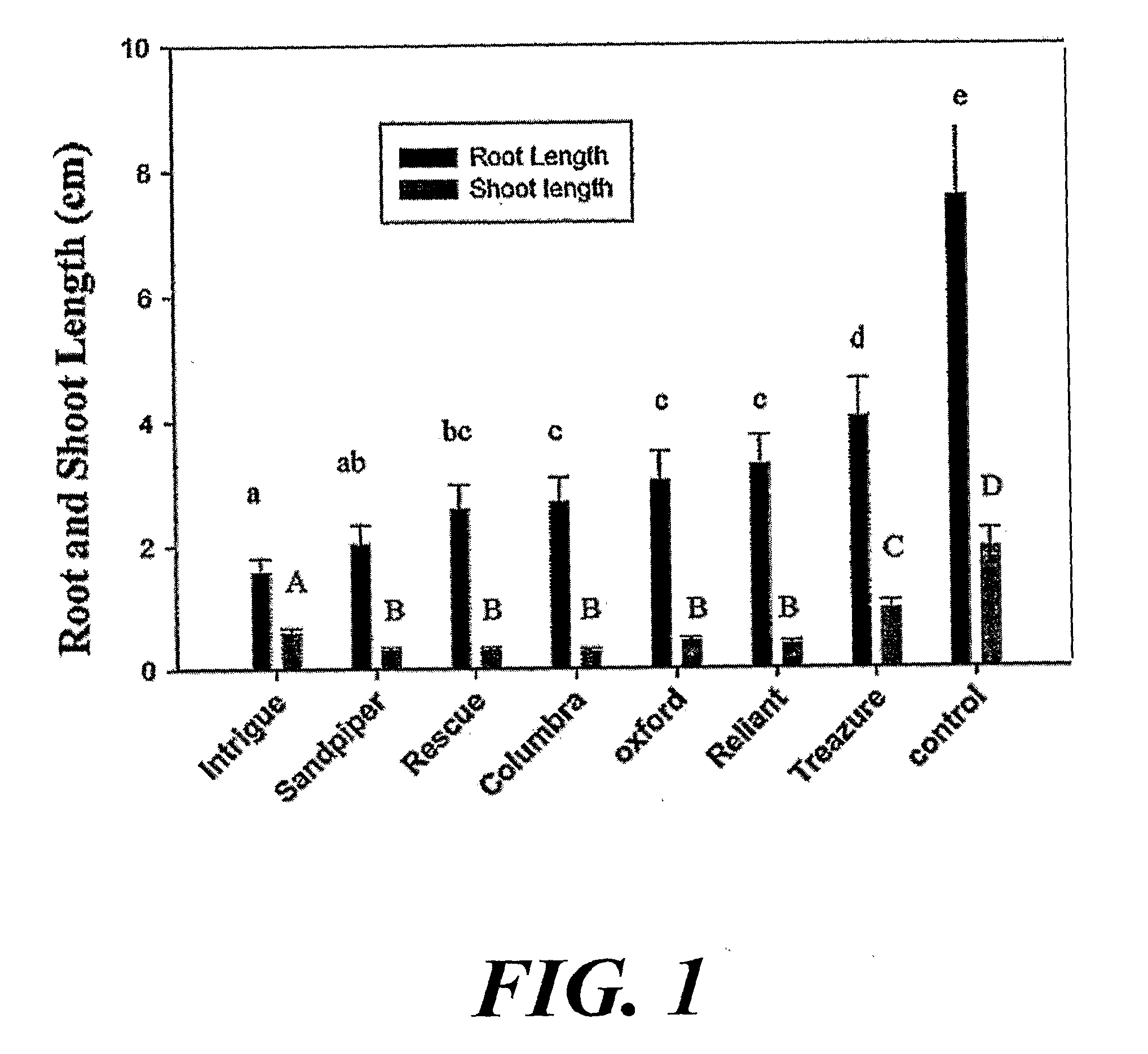Bioherbicide from Festuca Spp
a bioherbicide and festuca spp technology, applied in biocides, biocides, biochemical apparatus and processes, etc., can solve the problems of ineffective long-term control of turf weeds by biological and organic approaches, few commercial biocontrol products are currently available, and the use of herbicides in public and private landscapes is increasingly challenged. , to achieve the effect of inhibiting growth, and enhancing the growth of non-weed plants
- Summary
- Abstract
- Description
- Claims
- Application Information
AI Technical Summary
Benefits of technology
Problems solved by technology
Method used
Image
Examples
example 1
Laboratory Assessment of the Allelopathic Effects of Fine Leaf Fescues
[0076]As described in Examples 2-14 (herein), laboratory screening studies were conducted to evaluate the allelopathic potential of fine leaf fescues. Of the seven accessions selected from prior field evaluations for weed-suppressive ability, all inhibited root growth of large crabgrass and curly cress in laboratory assays. Grown in agar as a growth medium and in the presence of living fescue seedlings for 14 or 21 days, test species were sensitive depending on the fescue cultivars. Growth inhibition increased when fescue was grown for increasing periods of time in agar. Seedling fescues produced significant quantities of bioactive root exudates, which were released into the agar medium. Bioactive root exudates were extracted from living fescue roots by using methylene chloride. Shoot tissue was extracted in water and the aqueous extract was partitioned against hexane, ethyl acetate, and methylene chloride. Extrac...
example 2
Plant Materials and Screening for Allelopathic Potential of Living Fescue Root Exudates
[0077]Of the 78 fine leaf fescue cultivars evaluated in previous field studies (Bertin et al., “Further Evaluation of the Allelopathic Potential of Fine Leaf Fescue,”Proc WSSA 56:116 (2002), which is hereby incorporated by reference in its entirety), 7 were selected for further laboratory evaluation. These included Oxford (hard fescue), Reliant II (hard fescue), Rescue 911 (hard fescue), Sandpiper (chewings fescue), Intrigue (chewings fescue), Colurnbra (chewings fescue), and Treazure (chewings fescue) (Table 1).
TABLE 1FINE LEAF FESCUE CULTIVARS SELECTEDFOR FURTHER LABORATORY EVALUATIONWeed-suppressiveCultivar nameFescue typeSpeciesactivityaOxfordHard fescueFestuca longifolia L. ThuillHighReliant IIHard fescueFestuca longifolia L. ThuillModerateRescue 911Hard fescueFestuca longifolia L. ThuillModerateSandpiperChewingsFestuca rubra L. Subsp.HighfescueCommutata Gaud.IntrigueChewingsFestuca rubra L. ...
example 3
Root Exudate Collection Under Stressed and Nonstressed Conditions
[0081]Approximately 100 g of fine leaf fescue seed of each cultivar was surface-sterilized to reduce microbial contamination and then placed on to each of six screens of a capillary mat system used for seedling generation of large quantities of living root tissue (Czarnota. M. A., “Sorghum (Sorghum spp.) Root Exudates, Production, Localization, Chemical Composition, and Mode of Action,” in Floriculture and Ornemantal Horticulture, Ithaca, N.Y.: Cornell University, pp. 105 (2001), which is hereby incorporated by reference in its entirety). Seeds were allowed to germinate on the capillary mat system, and after 14 days, living roots were harvested by removal from the adjacent screen with a razor blade. Large quantities of healthy root tissue were harvested from each individual screen, and fresh weight was recorded. Collected root tissue was then dipped in 250 ml of methylene chloride for approximately 1 min. Roots were re...
PUM
 Login to View More
Login to View More Abstract
Description
Claims
Application Information
 Login to View More
Login to View More - R&D
- Intellectual Property
- Life Sciences
- Materials
- Tech Scout
- Unparalleled Data Quality
- Higher Quality Content
- 60% Fewer Hallucinations
Browse by: Latest US Patents, China's latest patents, Technical Efficacy Thesaurus, Application Domain, Technology Topic, Popular Technical Reports.
© 2025 PatSnap. All rights reserved.Legal|Privacy policy|Modern Slavery Act Transparency Statement|Sitemap|About US| Contact US: help@patsnap.com



